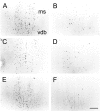Elevation of nerve growth factor and antisense knockdown of TrkA receptor during contextual memory consolidation
- PMID: 11157090
- PMCID: PMC6762334
- DOI: 10.1523/JNEUROSCI.21-03-01047.2001
Elevation of nerve growth factor and antisense knockdown of TrkA receptor during contextual memory consolidation
Abstract
We report here a series of experiments establishing a role for nerve growth factor and its high-affinity receptor TrkA in contextual memory consolidation. In all experiments, we trained rats in a novel chamber using tone and shock. Our first experiment revealed that endogenous nerve growth factor (NGF) increases in the hippocampus at a critical time during consolidation that occurs 1 week after training. NGF levels at other intervals (24 hr and 2 and 4 weeks after training) did not differ from those of naive control animals. In our second experiment, we blocked effects that NGF has at 1 week after training by infusing antisense TrkA phosphorothioate DNA oligonucleotide. Reduction of septohippocampal TrkA receptor expression selectively impaired memory consolidation for context but not for tone. Animals with antisense TrkA oligonucleotide infused into the medial septal area or CA1 of the hippocampus froze less when placed in the training chamber than did animals infused with inactive randomized oligonucleotide. At 4 weeks after training, antisense TrkA oligonucleotide had no effect on freezing. Third, we correlated levels of freezing with choline acetyltransferase (ChAT) and vesicular acetylcholine transporter (VAChT) immunohistochemistry. Antisense TrkA infused into CA1 of the hippocampus reduced cell body cross-sectional area for cholinergic cells in the medial septal area and decreased the density of hippocampal terminals labeled for ChAT and VAChT proteins. Cholinergic cell body measurements were significantly correlated with freezing. Taken together, these results indicate a role for nerve growth factor acting via the TrkA receptor on ChAT and VAChT proteins in contextual memory consolidation.
Figures







References
-
- Arvidsson U, Riedl M, Elde R, Meister B. Vesicular acetylcholine transporter (VAChT) protein: a novel and unique marker for cholinergic neurons in the central and peripheral nervous systems. J Comp Neurol. 1997;378:454–467. - PubMed
-
- Bejanin S, Cervini R, Mallet J, Berrard S. A unique gene organization for two cholinergic markers, choline acetyltransferase and a putative vesicular transporter of acetylcholine. J Biol Chem. 1994;269:21944–21947. - PubMed
-
- Berrard S, Varoqui H, Cervini R, Israël M, Mallet J, Diebler MF. Coregulation of two embedded gene products choline acetyltransferase and the vesicular acetylcholine transporter. J Neurochem. 1995;65:939–942. - PubMed
-
- Berse B, Blusztajn JK. Coordinated up-regulation of choline acetyltransferase and vesicular acetylcholine transporter gene expression by the retinoic acid receptor alpha cAMP and leukemia inhibitory factor/ciliary neurotrophic factor signaling pathways in a murine septal cell line. J Biol Chem. 1995;270:22101–22104. - PubMed
-
- Butcher LL, Oh JD, Woolf NJ, Edwards RH, Roghani A. Organization of central cholinergic neurons revealed by combined in situ hybridization histochemistry and choline-O-acetyltransferase immunocytochemistry. Neurochem Int. 1992;21:429–445. - PubMed
Publication types
MeSH terms
Substances
Grants and funding
LinkOut - more resources
Full Text Sources
Other Literature Sources
Medical
Miscellaneous
